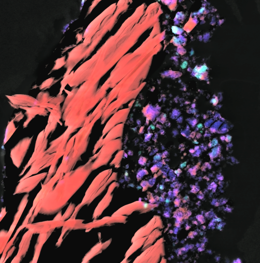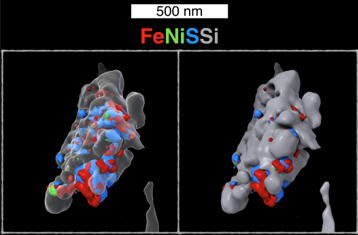
In this interview, AZoM talks to Zack Gainsforth, Research Scientist in the Westphal group at the UC Berkeley Space Sciences Laboratory, about their use of electron microscopy.
What is your background with electron microscopy? How long have you used EM in your work?
My first interaction was just curiosity. I walked into the EM lab as an undergraduate at Berkeley and said, hey, can I use your electron microscope? And they said, no. I suppose that was a fair response. But then later on, when I was working on Stardust (comet samples) we were using the synchrotron. A lot of other researchers in our field were using transmission electron microscopes instead. What I found out is that TEMs are essentially the Swiss Army knife for the subject, one of the most powerful tools for our particular application. So, I said, I need to learn the electron microscope! And then I went and learned it.

LRGB TEM image of a comet grain from comet Wild 2 returned by NASA’s Stardust spacecraft. Colors: HAADF (luminance), iron (red), magnesium (green), oxygen (blue). The large red object to the left is iron sulfide, the blue and green regions to the right contain nanoscale dust grains that tell us about the formation of the early solar system.
Can you give us the elevator pitch for your current research?
I study all sorts of samples that we get back from NASA (National Aeronautics and Space Administration), ESA (European Space Agency), JAXA (Japan Aerospace Exploration Agency), etc. Largely I work on interplanetary dust particles and comet samples brought back by NASA's Stardust spacecraft, as well as meteorites, which generally come from asteroids, and other such goodies.
So how is electron microscopy vital for this work?
So, initially our solar system formed from very small dust grains. Geological changes have largely erased any evidence of this process here on Earth, but when you look at something like a comet the impact of geology is obviously very minimal, and we can get better insight into how our solar system may have formed. The dust grains packed into comets are from micrometers down to nanometers in size, so, if you really want to understand what's going on, you have to be able to see clearly, all the way down to a few nanometers. And that’s the territory of electron microscopes.
What do you see in the future of EM? What needs to happen for us to get there?
I think there are actually several fronts where there's still room for improvement. For me, my bread and butter is EDS (energy dispersive X-ray spectroscopy) on a Titan TEM. What I find is that I often need to switch between different modes; so, 80 keV to 200 keV, for example.
This is because I'm often following an investigative track on my sample, which is some thing. I don't even know what it is when I start, which is maybe a little different than in other fields. That’s why I might start with EDS, determine what the elements are, and then switch to diffraction, imaging, etc. I might even have to go to a different microscope if I want to do something like EELS (electron energy loss spectroscopy).

An EDS tomographic reconstruction of a primitive dust grain found in comets. Colors: iron (red), nickel (green) and sulfur (blue). Sulfide grains (red + blue) are embedded in the surface of a silicate (transparent/opaque gray). Many small grains such as this one may have accreted to form Earth in the early solar system.
But the Titan has actually opened up a whole new realm compared to when I was using a Phillips CM200 and a Libra TEM. Both of those are great, but just the fact that I can switch 80 to 200 keV in one session, and only lose maybe an hour waiting for the system to stabilize, that's a big boon. But if that goes even further, I could envision a future where I'm acquiring EELS and EDS and then switching back and forth between voltages. Really just improving flexibility and speed.
Another front which is very exciting is the tight integration of microscopes with computers. I’ve been working on several projects where I control the TEM using a script in order to obtain information with greater accuracy/speed than I could get by hand. For example, by acquiring several hundred EDS spectra from specific angles relative to a crystal, I can determine in which lattice site a specific atom is located. This type of technique is very hard to do manually, but rather straightforward when you can write code to control the instrument.
Is there any recent work from your lab that you would like to highlight?
I’m very proud of our recent study of a comet grain from the Stardust mission. This work was carried out using a Titan TEM and synchrotron. It never ceases to amaze me that every single comet particle harbors unique surprises that we have never seen before. Perhaps, some years in the future, when we have seen many more comet samples, it will become routine, but at present the last frontier is still unknown and wild. (Read more: Fine‐grained material associated with a large sulfide returned from Comet 81P/Wild 2)
I have also been working on developing EDS tomography to study the 3D structure of these comet grains. This has only become possible in the last couple years thanks to high-solid-angle EDS detectors inside the TEM. I just presented some of our first results at this conference (M&M 2019) and I am really excited to see how this field develops over the next few years. I predict EDS tomography has a bright future. (Read more: STEM/EDS Tomography of Cometary Dust)
Is there anywhere our readers can go to learn more about your work?
I’ve been very lucky to be able to work and consult with a number of top-notch researchers at the Space Sciences Laboratory, especially Andrew Westphal. We occasionally highlight various activities on the lab’s home page.
I also consider myself privileged to have access to the amazing microscopes at the Molecular Foundry at Berkeley. The staff and resources there are unique and vital to our research and to NASA’s mission.
About Zack Gainsforth
 Zack Gainsforth is a Research Scientist in the Westphal group at the UC Berkeley Space Sciences Laboratory. We sat down with him at the Microscopy & Microanalysis 2019 Meeting to discuss his background with EM and what he hopes to see in the future of the technique.
Zack Gainsforth is a Research Scientist in the Westphal group at the UC Berkeley Space Sciences Laboratory. We sat down with him at the Microscopy & Microanalysis 2019 Meeting to discuss his background with EM and what he hopes to see in the future of the technique.
Disclaimer: The views expressed here are those of the interviewee and do not necessarily represent the views of AZoM.com Limited (T/A) AZoNetwork, the owner and operator of this website. This disclaimer forms part of the Terms and Conditions of use of this website.